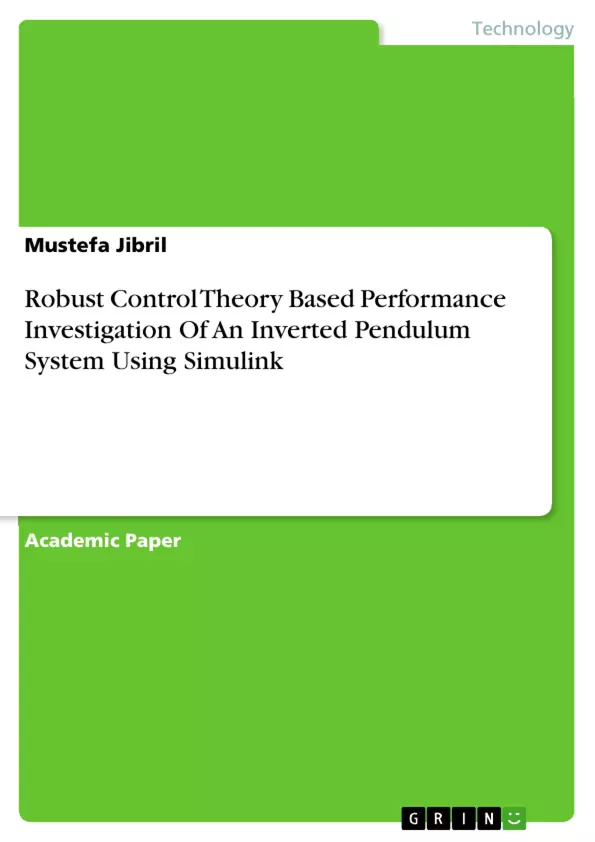In this paper, the performance of inverted pendulum have been Investigated using robust control theory. The robust controllers
used in this paper are H∞ Loop Shaping Design Using Glover McFarlane Method and mixed H∞ Loop Shaping Controllers.
The mathematical model of Inverted Pendulum, a DC motor, Cart and Cart driving mechanism have been done successfully.
Comparison of an inverted pendulum with H∞ Loop Shaping Design Using Glover McFarlane Method and H∞ Loop Shaping
Controllers for a control target deviation of an angle from vertical of the inverted pendulum using two input signals (step and
impulse). The simulation result shows that the inverted pendulum with mixed H∞ Loop Shaping Controller to have a small rise
time, settling time and percentage overshoot in the step response and having a good response in the impulse response too.
Finally the inverted pendulum with mixed H∞ Loop Shaping Controller shows the best performance in the overall simulation
result.
Inhaltsverzeichnis (Table of Contents)
- Introduction
- The Proposed Controllers Design
- H∞ Mixed-Sensitivity Synthesis Method for Robust Control Loop Shaping Design of Inverted Pendulum
- H∞ Loop Shaping Design Using Glover McFarlane Method Control of Inverted Pendulum
- Result and Discussion
- Simulation of the inverted pendulum without Controller
- Simulation of the inverted pendulum with H∞ mixed sensitivity and H ∞ Loop shaping design using Glover McFarlane controllers using step input error voltage signal
- Simulation of the inverted pendulum with H∞ mixed sensitivity and H ∞ Loop shaping design using Glover McFarlane controllers using Impulse input error voltage signal
- Numerical Values of the Simulation Output
- Conclusion
Zielsetzung und Themenschwerpunkte (Objectives and Key Themes)
This paper investigates the performance of an inverted pendulum system using robust control theory. The paper explores the application of H∞ Loop Shaping Design Using Glover McFarlane Method and mixed H∞ Loop Shaping Controllers to stabilize the inverted pendulum. The mathematical model of the system, including a DC motor, cart, and cart driving mechanism, is developed and analyzed. The paper compares the performance of the inverted pendulum with different controllers using step and impulse input error voltage signals. Through simulation results, the paper seeks to determine the effectiveness of the different controllers in achieving desired performance objectives.
- Robust control theory applied to an inverted pendulum system.
- Comparison of H∞ Loop Shaping Design Using Glover McFarlane Method and mixed H∞ Loop Shaping Controllers.
- Mathematical modeling of an inverted pendulum system.
- Performance evaluation of controllers using step and impulse input signals.
- Analysis of simulation results to determine optimal control strategies.
Zusammenfassung der Kapitel (Chapter Summaries)
- Introduction: This chapter provides an overview of the inverted pendulum system and its significance in control engineering. It highlights the inherent instability of the system and the need for robust control strategies to achieve stabilization. The chapter introduces the design components of the inverted pendulum system, including the DC motor, cart, pendulum, and cart driving mechanism. It also outlines the challenges associated with stabilizing the inverted pendulum, such as its nonlinear nature, non-minimum phase characteristic, and under-actuation.
- The Proposed Controllers Design: This chapter details the design of two robust controllers for the inverted pendulum system. The first controller utilizes the H∞ mixed-sensitivity synthesis method for robust control loop shaping, while the second controller employs the H∞ Loop Shaping Design using Glover McFarlane method. The chapter explains the principles and methodologies behind each control approach and provides a detailed description of the control architecture used for each controller.
- Result and Discussion: This chapter presents the simulation results and analysis of the inverted pendulum system with and without the proposed controllers. The chapter includes simulation models and outputs for both step and impulse input error voltage signals. It provides a comparative analysis of the performance of the controllers based on metrics such as rise time, settling time, and percentage overshoot. The chapter also discusses the effectiveness of each controller in stabilizing the inverted pendulum system and achieving the desired performance objectives.
Schlüsselwörter (Keywords)
The main keywords and focus topics of this paper include inverted pendulum, robust control theory, H∞ loop shaping, Glover McFarlane method, mixed sensitivity control, DC motor, cart, pendulum, step response, impulse response, rise time, settling time, percentage overshoot, simulation, and Matlab/Simulink.
- Quote paper
- Mustefa Jibril (Author), 2020, Robust Control Theory Based Performance Investigation Of An Inverted Pendulum System Using Simulink, Munich, GRIN Verlag, https://www.grin.com/document/542102



